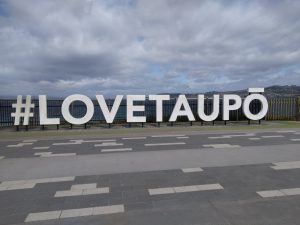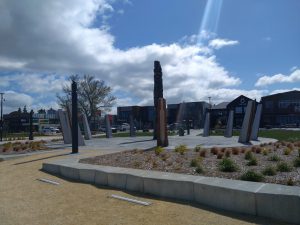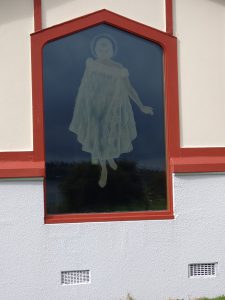ニュージーランドを初訪問、南北両島を車で無理やり巡る弾丸ツアー⑥最終回『最後の3日間』/The first visit to New Zealand, Bullet tour to drive both of North and South Islands⑥Final Volume“The last 3 days in New Zealand”

(黄色部分が今回の旅程)
I initially planned to summarize my visit to New Zealand in a four-part series, but it ended up being six parts. This marks the final installment, where I’ll cover the last three days of my journey in New Zealand.
(Engish text continues to the latter half of the page)
当初は4回シリーズでまとめようと考えていたニュージーランド訪問記ですが、結局6回になってしまいました。これで最終回になります。ニュージーランドの最後の3日間をまとめてみました。
タウポ湖へドライブの後、Rotorua市内の源泉公園を散策
Rotorua最後の日の朝は、南へ80㎞のところにあるタウポ湖(Lake Taupo)へドライブ。タウポ湖はニュージーランド最大の表面積を持つ湖(616㎢、琵琶湖が670㎢)で、AD181年の巨大噴火によって形成されたカルデラ湖で、歴史を通して巨大な噴火を繰り返しており、現在でも周囲には温泉や地熱地帯が広がっている。まずは湖の北端にあるAratiatia Rapidsへ。ここはタウポ湖の水を堰き止めている水門で、毎日10:00、12:00、14:00の3回(夏季には4回)ゲートを開き毎秒9万Lの水が渓流に流れ込む。渓谷にみるみる水が満ちていくシーンはなかなか見られないものだ。
さらに少し進んだところにあるのがフカ滝。実はニュージーランド全土で最も観光客が集まるところだそうだ。決して大きな落差を持つ滝ではないものの、美しく青く澄んだ水が一気に吐き出される様は圧巻。現地ではここにジェットボートで突っ込んでいくのが定番のアクティビティになっている。
タウポ湖は風が強いところ、その特性を利用してか湖畔から湖中のグリーンに向かってホールインワンを狙うアクティビティがある。50球で$NZ50(≒450円)、ホールインワン達成の場合は$NZ10,000(≒90万円)。10分ほど見ていたけど、もちろんホールインワンはおろか、ワンオンした人もいなかった。




湖畔に広がる街区はとても穏やかで、のんびり散策するにはぴったり。次回来た時には数日ゆっくり滞在して、この先のトンガリロ国立公園まで足を延ばしたいところだ。


Rotorua中心部の源泉公園と、湖畔のマオリ集落
北島観光の拠点の一つになっている街Rotoruaだが、街中にも数多くの源泉、泥湯が湧き出ている。下の動画にあるように、公園の中には木柵に囲まれて無数の泥湯や温泉が湧いてる。
公園の端では、たまたま朝市をやっていた。小雨が降り続いていたのが残念。




Rotorua湖畔にはオヒネムトゥ村と呼ばれるマオリの集落もある。いわゆる観光客向けに昔ながらの原住民としての生活を再現したものではなく、近代的な建築物が並び、マオリの人々は普通にRotorua市民として生活している。その中にあるチューダー様式のキリスト教会は普段は会堂の中を公開しているそうだけど、訪問した日がたまたま集落の葬式があり入れなかった。会堂のガラス窓にはキリストのレリーフが描かれ、会堂の中から眺めるとまるでRotorua湖の水面を歩いているかのように見えるらしい(下写真の4枚目)。この集落もそこら中から蒸気が沸き立つ地熱地帯の上に建てられており、昔から調理や暖房に活用されているそうだ。







(Yellow shadow is the itinerary of the article)
I initially planned to summarize my visit to New Zealand in a four-part series, but it ended up being six parts. This marks the final installment, where I’ll cover the last three days of my journey in New Zealand.
Taking a walk in Rotorua city park after driving to Lake Taupo
On the last morning in Rotorua, I took a drive south to Lake Taupo, located 80 km away. Lake Taupo is New Zealand’s largest lake in terms of surface area (616 sq km, compared to Lake Biwa’s 670 sq km). It is a caldera lake formed by a massive eruption in 181 AD, and throughout history, it has experienced significant volcanic activity. Even today, there are hot springs and geothermal areas around its shores. I first visited Aratiatia Rapids at the northern end of the lake. This location has a dam that holds back the waters of Lake Taupo. The gates are opened three times a day (four times in summer) at 10:00, 12:00, and 14:00, releasing 90,000 liters of water per second into the gorge. The sight of the rapidly filling canyon is a rare and impressive spectacle.
A bit further ahead is Huka Falls, which happens to be the most visited attraction throughout New Zealand. While it doesn’t have a tremendous drop, the spectacle of the beautifully clear, blue water gushing out all at once is breathtaking. Jet boating into the falls has become a popular activity at this location.
At Lake Taupo, where the wind can be strong, there is an activity that takes advantage of this feature. From the lakeside, participants aim for a hole-in-one towards a green target in the lake. It costs $NZ50 for 50 balls, with a chance to win $NZ10,000 (approximately ¥900,000) for achieving a hole-in-one. I watched for about 10 minutes, but of course, there were no hole-in-ones, and no one even got close.




The neighborhoods along the lakeside are very serene, making it a perfect place for a leisurely stroll. On my next visit, I would like to stay for a few days and extend my journey to Tongariro National Park and beyond.


Hot spring park in the center of Rotoruaand Maori Colony by the lake
Rotorua, a city serving as a hub for North Island tourism, is home to numerous springs and mud pools. As shown in the video below, within the parks, there are countless mud pools and hot springs enclosed by wooden fences.
At the edge of the park, there happened to be a morning market. It was a bit unfortunate that light rain continued.




There is a Maori village called Ohinemutu on the shores of Lake Rotorua. It’s not a traditional recreation of indigenous life for tourists; rather, it consists of modern buildings, and the Maori people live their everyday lives as citizens of Rotorua. Within this village, there is a Tudor-style Christian church, which is usually open to the public, but unfortunately, it was closed on the day of my visit due to a funeral in the village. The church’s stained glass windows depict scenes of Christ, and when viewed from inside, it apparently gives the illusion of walking on the surface of Lake Rotorua (fourth photo below). This village is also built on a geothermal area with steam rising from various places, which has been traditionally used for cooking and heating.






